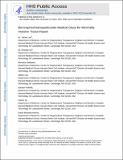| dc.contributor.author | Xu, Chenjie | |
| dc.contributor.author | Sebastin, Monisha | |
| dc.contributor.author | Lee, Albert | |
| dc.contributor.author | Holwell, Nathan | |
| dc.contributor.author | Xu, Calvin | |
| dc.contributor.author | Mu, Luye | |
| dc.contributor.author | Miranda-Nieves, David | |
| dc.contributor.author | Lee, Yuhan | |
| dc.contributor.author | Langer, Robert S | |
| dc.contributor.author | Lin, Charles | |
| dc.contributor.author | Karp, Jeffrey Michael | |
| dc.date.accessioned | 2017-05-30T14:44:32Z | |
| dc.date.available | 2017-05-30T14:44:32Z | |
| dc.date.issued | 2015-11 | |
| dc.date.submitted | 2015-06 | |
| dc.identifier.issn | 2192-2640 | |
| dc.identifier.uri | http://hdl.handle.net/1721.1/109410 | |
| dc.description.abstract | Delivery of tissue glues through small-bore needles or trocars is critical for sealing holes, affixing medical devices, or attaching tissues together during minimally invasive surgeries. Inspired by the granule-packaged glue delivery system of sandcastle worms, a nanoparticulate formulation of a viscous hydrophobic light-activated adhesive based on poly(glycerol sebacate)-acrylate is developed. Negatively charged alginate is used to stabilize the nanoparticulate surface to significantly reduce its viscosity and to maximize injectability through small-bore needles. The nanoparticulate glues can be concentrated to ≈30 w/v% dispersions in water that remain localized following injection. With the trigger of a positively charged polymer (e.g., protamine), the nanoparticulate glues can quickly assemble into a viscous glue that exhibits rheological, mechanical, and adhesive properties resembling the native poly(glycerol sebacate)-acrylate based glues. This platform should be useful to enable the delivery of viscous glues to augment or replace sutures and staples during minimally invasive procedures. | en_US |
| dc.description.sponsorship | United States. National Institutes of Health (GM086433) | en_US |
| dc.description.sponsorship | United States. National Institutes of Health (DE013023) | en_US |
| dc.language.iso | en_US | |
| dc.publisher | Wiley Blackwell | en_US |
| dc.relation.isversionof | http://dx.doi.org/10.1002/adhm.201500419 | en_US |
| dc.rights | Creative Commons Attribution-Noncommercial-Share Alike | en_US |
| dc.rights.uri | http://creativecommons.org/licenses/by-nc-sa/4.0/ | en_US |
| dc.source | PMC | en_US |
| dc.title | Bioinspired Nanoparticulate Medical Glues for Minimally Invasive Tissue Repair | en_US |
| dc.type | Article | en_US |
| dc.identifier.citation | Lee, Yuhan; Xu, Chenjie; Sebastin, Monisha; Lee, Albert; Holwell, Nathan; Xu, Calvin; Miranda Nieves, David et al. “Bioinspired Nanoparticulate Medical Glues for Minimally Invasive Tissue Repair.” Advanced Healthcare Materials 4, no. 16 (July 2015): 2587–2596 © 2015 WILEY-VCH Verlag GmbH & Co. KGaA, Weinheim | en_US |
| dc.contributor.department | Massachusetts Institute of Technology. Institute for Medical Engineering & Science | en_US |
| dc.contributor.department | Harvard University--MIT Division of Health Sciences and Technology | en_US |
| dc.contributor.department | Koch Institute for Integrative Cancer Research at MIT | en_US |
| dc.contributor.mitauthor | Miranda-Nieves, David | |
| dc.contributor.mitauthor | Lee, Yuhan | |
| dc.contributor.mitauthor | Langer, Robert S | |
| dc.contributor.mitauthor | Lin, Charles | |
| dc.contributor.mitauthor | Karp, Jeffrey | |
| dc.relation.journal | Advanced Healthcare Materials | en_US |
| dc.eprint.version | Author's final manuscript | en_US |
| dc.type.uri | http://purl.org/eprint/type/JournalArticle | en_US |
| eprint.status | http://purl.org/eprint/status/PeerReviewed | en_US |
| dspace.orderedauthors | Lee, Yuhan; Xu, Chenjie; Sebastin, Monisha; Lee, Albert; Holwell, Nathan; Xu, Calvin; Miranda Nieves, David; Mu, Luye; Langer, Robert S.; Lin, Charles; Karp, Jeffrey M. | en_US |
| dspace.embargo.terms | N | en_US |
| dc.identifier.orcid | https://orcid.org/0000-0002-3253-7799 | |
| dc.identifier.orcid | https://orcid.org/0000-0002-0616-022X | |
| dc.identifier.orcid | https://orcid.org/0000-0003-4255-0492 | |
| mit.license | OPEN_ACCESS_POLICY | en_US |
